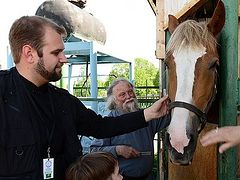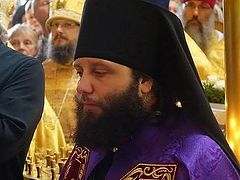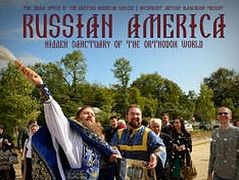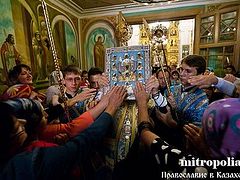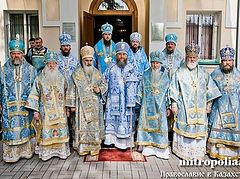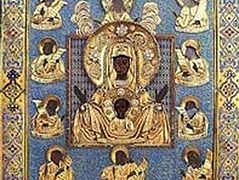In this interview Archbishop Kyrill of San Francisco and Western America speaks about his November 2013 trip to Russia and Japan.
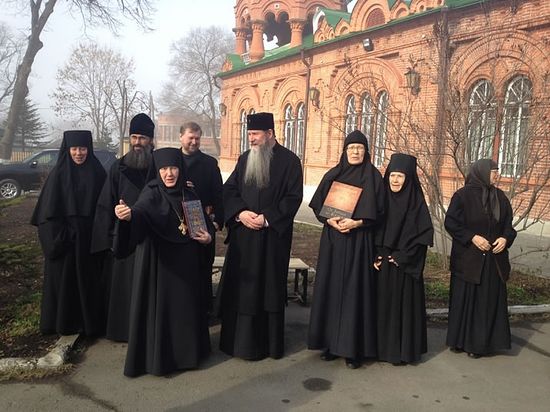
Zoya Gradov: Vladyka, please tell us about your trip to Russia and Japan. Was the purpose of the trip related to the disaster in Eastern Russia?
Archbishop Kyrill: As far as the natural disaster, the timing was purely coincidental. The places to which we had been invited - Vladivostok, Nakhodka, Ussuriysk, Arsenyev - were a great distance from the areas that were afflicted by the flood.
It all happened the following way: A few years ago, a family from Kyoto requested that we bring the Kursk Root Icon to Japan. The lady of the house was from Russia, and had met her husband, a Japanese man, while he was studying abroad. They fell in love, got married, and moved to Japan. Now they have three children. This family had persisted for three years in their efforts to bring the icon to their country. For three years they prayed to the Mother of God to bring the icon to Japan. And suddenly, everything came together: the Japanese Orthodox church sent us a letter, inviting us to visit, and we were in a position to acquiesce. Meanwhile, the Primorsk Diocese, headed by Metropolitan Benjamin (Veniamin), found out about our trip and extended an invitation of their own. The trip from Tokyo would take a mere two hours, so of course, we agreed. It was right around this time that disaster struck in the Far East of Russia. We collected donations from all over the Western American Diocese to help these poor people (and continue to do so), and thanks to our trip to Japan, I was able to bring the first installment of a good sum of money to Ataman Cossack General Oleg Anatolievich Melnikov, who was spearheading a relief effort for victims of the flood. He, in turn, awarded me with the Medal of the Protection of the Theotokos.
- Is there a resurgence of Cossack groups in the area?
- In each city we visited, we were welcomed, received, and looked after by Cossacks. In his time, Stalin attempted to annihilate them, but the Cossacks are experiencing a revival in Russia. And by the way, this particular ataman has six thousand Cossacks in his command - all of them in full uniform.
- The American media didn’t say a single word about the devastation suffered by the people of Eastern Russia. Usually, whenever there is a natural disaster, such as the recent typhoon in the Philippines, it is thoroughly covered by radio and television, with constant appeals for aid. People are informed about the event and they want to help. But in this case, except for people who visit Russian news websites or have access to Russian news channels, nobody knew. How did your parishioners respond when you asked them to help?

- In my view, America is, to some extent, reliving the era of the Soviet Union: This really reminds me of the Cold War. With the collapse of the Soviet Union, things seemed to get easier for us here. But Russophobia is beginning to spread again. As a clergyman, I experience this quite a bit. Of course, America will not answer the call to help Russia. It is more likely to dwell on Russia’s shortcomings in order to demean it. That is why we didn’t hear anything about the tragic events in the Far East, the aftermath of which is still being felt.
I must give credit to the person who initiated the call to action in our diocese. I had read about the disaster on the website of the Moscow Patriarchate and thought that we must help in some way. And suddenly, the phone rings and the voice of Nikita Evgenievich Buick, warden of our cathedral, can be heard on the other end: “Vladyka, let’s help!” I suggest that we form a plan of action and issued a decree that every parish might collect as much as it could, the sum of which I would then deliver to Russia. We raised twenty thousand dollars this way. After my departure, one of our parishes contributed another four thousand, and Nikita Evgenievich secured another twenty. Besides the financial help, there is another crucial, psychological effect: People don’t feel discarded. The simple fact that their fellow Orthodox Christians care for and worry about them eases some of their anguish.
- Returning to the subject of the trip…
- We were met in Tokyo by Father Nikolai Kotsuban, dean of the St Alexander Nevsky church (Moscow Patriarchate), a Russian diplomat, and two nuns from the St. Sophia Monastery, which is located in the village of Matsuo. When we arrived at the monastery, we performed an akathist and the sisters fed us, after which we set out for Kyoto, the ancient capital of Japan. The family that had prayed for three years that the Kursk Root Icon should be brought to Japan resided in that very city. They welcomed us into their home, where we stayed for four days. What a dinner they prepared for us that evening! I considered myself fairly familiar with Japanese cuisine, but I didn’t know it as well as I thought. Needless to say, the meal was delicious.
- Did you stay in a traditional Japanese house?
- No, they live in what they call an “American” style house. It really is built in the manner of Western houses, but they have one Japanese-style room, complete with tatami [straw matting], where they have their krasny ugol [“beautiful corner”] and a great many icons and an oil-burning lamp before them.
We, as tourists, were taken sightseeing. It was interesting to see a traditional Japanese city. The twar had spared Kyoto - everything has remained as it was a century ago. The Cathedral of the Annunciation in Kyoto is around one hundred years old.
The service was attended by a good number of people, so we had two chalices for Holy Communion. It was then that we witnessed the first of the icon’s miracles that would occur over the course of our trip. Toward the end of the liturgy, a young lady of Russian descent came into the church and approached one of the priests, saying: “I was never baptized, but something drew me into the church and I think that I should be.” The priest set a day to meet with her so that he could prepare her for her christening.
- Is the Kyoto parish a large one?
- Not very big. But, in general, there are only around thirty thousand Orthodox Christians in Japan, most of them of Japanese descent. There aren’t many Russians.
We left Kyoto for Tokyo, where we met with Metropolitan Daniel, head of the autonomous Japanese Orthodox Church. I served alongside the Metropolitan at the renowned Nikolai-do Cathedral, built by St. Nikolai of Japan, who had come to Japan as a missionary in the mid-1800s. A small Russian colony had survived in the area. After the liturgy, these Russians invited us to join them for some Russian tea. Here we were, in Japan - in the land of the rising sun - being treated to pierogi, rye bread, caviar, andseelyodka [pickled herring]! Most of our hosts were from Harbin or Shanghai. Photographs of the bishops who had served in Harbin hung on their walls.
We had also planned on visiting the Orthodox parish in Sendai, but our visit was inexplicably canceled at the last minute.
- Vladyka, didn’t your family at one point live in Japan?
- They lived in Nagasaki. We weren’t able to visit there - it’s in a different part of Japan. We did visit the foreign cemetery in Tokyo, where, by the way, the grandparents of Dmitri Shikalov, the subdeacon of our cathedral in San Francisco, are buried.
- After Tokyo, you set out for Vladivostok?
- In Vladivostok, something extraordinary was happening. It was, after all, November and everything was supposed to be covered in snow. We were expecting cold and wind. But it was 3°, 4°C [37°–39° F] above zero in Vladivostok. We were told that all of the storm clouds had been chased away by wind: the Icon of the Theotokos had arrived.

The icon had been subject to a safety inspection, photographed and registered with customs. But the customs officers were making the sign of the cross and venerating the icon - we were amazed by this. Those who grew up in the West couldn’t possibly imagine such a thing! What a great change in Russia!
- Nor those who grew up in the Soviet Union.
- I took the icon and the priests followed me. The doors to the main hall of the airport opened. And what did I see? A carpet had been rolled out. I was standing before the open doors, and at the other end was Metropolitan Benjamin (Veniamin) of Vladivostok and Primorsk, dressed in his mantiya [mantle]. I walked toward him and he took the icon from me. We were surrounded by two rows of priests on either side of the carpet, which led to an analoi [stand], upon which the icon was placed. Cossacks, travelers, police - so many people from different walks of life were greeting the Icon of the Mother of God.
The protodeacon turned to the metropolitan: “Most Reverend Vladyka, bless.” The Metropolitan gave his blessing and then - “Glory be to Thee, O God, glory to Thee…” Then they began to sing the prayer to the Holy Spirit (“O Heavenly King…”) and everyone was singing along with them. The walls were shaking. I wept. Now, I can speak about it calmly, but at first I would weep every time I recalled it. Imagine this in America, imagine such a reception here, at the San Francisco Airport. They wouldn’t allow it because, God forbid you “offend” someone.
A complete molieben te deum was performed at the Vladivostok airport. And, as the people came up to venerate the icon, the Metropolitan gave a sermon. “We must all awaken,” he said to the people, “from our spiritual slumber. The Mother of God has come to us. The Hodigitria of the Theotokos heralds many miracles. Without these sacred objects, we cannot live. We need spiritual ground upon which to build our spiritual life.” Then he added: “We, the Russian people, must repent our regicide [murder of the anointed of God Emperor Nicholas II]; we slaughtered the anointed of God.” He indicted the Communists and the Soviet state for their moral degradation - it occurred to me that only twenty years ago he would have been arrested on the spot for it, but now he could speak freely. Vladyka gave wonderful sermons while we were with him in Vladivostok and Ussuriysk. A portrait of Tsar Nicholas II with Tsarevich Aleksei hung in his office. It was clear that the man is a monarchist.
I will never forget the reception at the airport, that call to action: Rise and walk in the footsteps of Christ. I will remember it for the rest of my life.
I experienced a similar depth of faith during my visit to the Diveyevo Monastery in 2003. We happened to be there in November, on the eve of the feast of the Archangel Michael. Everything was covered in snow. We had a flight to Moscow and could only stay for the first part of Matins. Our delegation had already left the church. I had been delayed in the altar, for one reason or another, and was the last to leave. Those who have been in Russia know that there is usually a runner stretching down the middle of any church, sectioned off by a velvet rope on either side, beyond which the parishioners stand. In my own cathedral, I would have traversed it within a minute, and nobody would have paid me the slightest attention. Not so in Russia: They see a clergyman upon whom grace has been bestowed. People on both sides began asking for a blessing. I was giving blessings with both hands. Even still, it was impossible to bless everyone. I felt someone pulling on my cassock, kissing the hem, the sleeves, my hands.… And all I could hear was, “Vladyka, bless…”
I saw such faces, such profound eyes, when I was in Russia this time - just as I had then [in Diveyevo]. The eyes are, after all, the windows to the soul, and one cannot possibly describe the depth, the candor of the Russian soul. One must experience it firsthand. We don’t have it in the West. Even Russians who grew up here don’t have it, since any society is bound to leave its imprint on the spirit. It’s completely different in Russia. I’m sure that anyone who only recently immigrated from Russia will understand what I experienced. Those who were born here must experience it themselves, because explaining it is nearly impossible.
- You know, for those of us who came from Russia, it is vital that we return at least once a year, in order to recharge our spiritual energy. We just can’t live without these visits.
- There is a cold-bloodedness here in the West. “I” is the most important - what’s convenient for me. Instead of immersing ourselves in our spiritual lives, we immerse ourselves in convenience, pointing the finger at everything and everyone else. Spirituality does not exist here. And many Orthodox Christians in the West simply don’t have an understanding of Orthodoxy as a foundation for their lives. That is what I’d like to underscore: Regardless of where I was in Russia, I felt that there was spirituality.
- How did the people receive the Icon?
- We arrived at the hotel in Vladivostok and were invited to dinner by the vicar. We talked like Russians do, only without the vodka. It was pleasant and effortless.
The next day we went to the church, where crowds had already gathered and were waiting for us. During our time there, around fifty thousand people came to venerate the icon. That might not seem like much compared to the entire population of Vladivostok and the surrounding areas, but it does show that there is a revival of spirituality taking place in Russia. Putin granted full autonomy to the Russian Orthodox Church. In the West, Putin is often criticized, even by Russians, but the possibilities open to the Patriarch and the Church would not have been conceivable just twenty years ago.
- How long were you in Vladivostok?
- About three days, and that entire time people were coming to visit the icon. While the icon was made available for people to visit, we went to see the Marfo-Mariinsky Convent in Sedanka. Abbess Maria and the sisters gave us a very warm welcome. There are twenty six nuns at the convent. The sisters told me that the Bolsheviks had desecrated it, using it as a palace of culture, a children’s institution, and a film studio, among other things. During perestroika, the land was returned to the convent, and the church, along with the bell tower, were rebuilt.
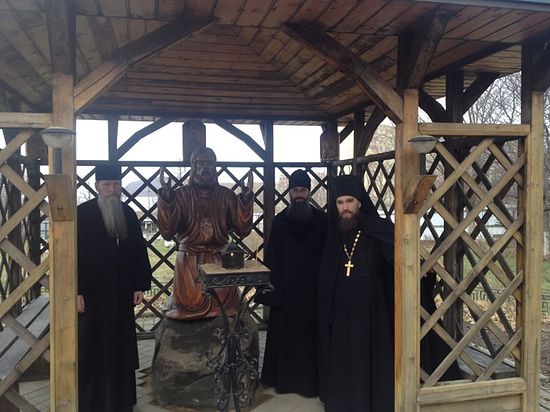
While in Vladivostok, I also had an opportunity to visit the St. Seraphim of Sarov Monastery, which is located on Russian Island. They’re in the process of restoring it. The monastery has forty beehives, livestock, chickens, and the customary Russian rooster that crows every morning. Guard dogs protect the monastery.
This is an extraordinary place that made me remember who I was: my monastic vows, my own spiritual abjection, as well as my personal one and that of my life in general. I was truly glad to visit that monastery.
We also visited the Far Eastern Federal University. The campus is colossal. Everything is modern, clean, and orderly. The university has a theology department which offers a master’s degree in theology. The head of the department is Metropolitan Benjamin (Veniamin) of Vladivostok and Primorsk himself, with Bishop Innokenty of Ussuriysk serving as the senior professor.
Bishop Innokenty and I then visited the Church of the Dormition in Vladivostok, of which he is the dean.
- Where did you go after Vladivostok?
- To Nakhodka. There we were met with a wonderful reception once again, and by the Russian people and their profound faith.
I performed the liturgy twice - once in Vladivostok and once in Nakhodka; in Vladivostok with Metropolitan Benjamin (Veniamin), in Nakhodka with Bishop Nikolai. The Patriarch had divided large dioceses into several manageable parts. Such a division had been discussed as far back as the Great Council of 1917. The distances between parishes here are massive, and a bishop is simply unable to traverse them, however much he would like to. There was even a saying, that some priests would only see their bishop once in a lifetime-at their ordination. So now the vast Primorsk diocese has become a metropolis, containing three dioceses. Metropolitan Benjamin (Veniamin) sits at its head, with Innokenty of Ussuriysk serving as his auxiliary, and Bishops Nikolai of Nakhodka and Gurii of Arsenyev overseeing the other two.
- I saw a photograph on the website of you placing flowers on a memorial. What is this memorial for?
- This is a memorial for a mother waiting for her children, who have perished at sea. Nakhodka is, after all, a port.
- And the village near Nakhodka -is that the one settled by repatriates from Australia?
- Yes, they are the ones who received us. And the first thing that I saw when I came into the dining hall were large portraits of Emperor Nicholas II and the Empress Alexandra Fyodorovna. The bishop himself says that Russia needs a tsar. That is the type of thing I heard there. It’s gladdening but somehow difficult to believe.
Then we traveled to Irkutsk. We performed the midnight liturgy there, and then visited the Monastery of the Nativity of the Theotokos. I asked the abbess, “How do you survive here? Where do you get the resources?” She told me that they do everything themselves. They have 740 hectares of land, with livestock, chickens, ducks, and sheep. The nuns spin wool and make blankets out of it. They grow vegetables and fruits, and they have five ponds in which they farm fish. In short, they feed and clothe themselves. Otherwise, survival is impossible. There just isn’t enough money.
It was nice to see that all of the monks and nuns that I met were educated people. It is very gratifying that people with a higher education seek out the monastery.
- The intelligentsia kindled the revolution, put a lot of effort into stamping out the faith of the people, and destroyed Russia. Now it is restoring it - the spiritual revival of the nation is being generated by the intelligentsia. It’s as though things have come full circle.
- Yes, and the mockery and slander of Empress Alexandra Fyodorovna was spawned by the intelligentsia as well. Now, in any church you might visit, you will see the icon of the Tsar-Martyr and the royal family. There is a chapel, built in honor of the Icon of the Mother of God “Derzhavnaya” [Sovereign] and the martyred royal family at the Monastery of the Nativity of the Theotokos. I saw the Tsar’s portrait in many places. For example, we were passing through a village near Nakhodka where the town church was under restoration. We were invited to visit a home, which had belonged to a priest priot to the revolution. It was, of course, somewhat decrepit, but they were intent on preserving it. At the time of the revolution, the priest who owned the home, who was also a priest, was gunned down alongside his family by the Bolsheviks. Today, a portrait of Tsar Nicholas II hangs in the house. When I noticed it, I mentioned to Vladyka Nikolai how heartening it was to us as descendants of Russian refugees. Vladyka said that the portrait had been placed there only recently. During Communism, it could not possibly have been kept in that place. People had to hide such portraits, and anything else having to do with the royal family. Now these things are being brought back. We saw oil paintings of His Majesty Nikolai Alexandrovich and Her Majesty Alexandra Fyodorovna displayed in the dining hall where we had our farewell dinner in Ussuriysk. We also saw the icons of our St. John of Shanghai and San Francisco the Wonderworker in many places. He is truly revered in Russia.
After Ussuriysk we moved on to the city of Arsenyev. My travels to the village of Muraveika with Vladyka Gurii, the reigning bishop of that area, were particularly memorable. When we arrived, all I could see were mountains and forest. It seemed to me that I had stepped into a time machine and came out in the nineteenth century. The only indication that we were in the modern day was a pair of cars nearby. If they had not been there, it would be impossible to say with any certainty what century one was in: the nineteenth, the twentieth, or the twenty-first.
Vladyka Gurii had acquired a house in this village and turned it into a church. He erected a cupola and split one of the rooms into two halves-one for an altar, one for a nave, where people gather to pray. The other room in the house is a little kitchen with a table, where he can receive guests and serve them tea. The local people aren’t particularly educated in the faith, but they do have a thirst for knowledge.
Vladyka Gurii had come to Muraveika to bless a well. Imagine: It’s the middle of winter, it’s sleeting, and he’s in his lesser verstments and mantiya. Naturally, the altar boys held the mantle up as high as they could. It turned out that he had forgotten the kropilo [aspergillum], but the vladyka didn’t miss a beat. He used the generous tassel of his chotki (prayer rope) to give everyone a good sprinkling. The well water was sweet, as were the refreshments in that little kitchen. Vladyka shared the following with me: “The people here don’t understand or know much of the faith, but they want to know Christ, and that is enough for me.” What a missionary this bishop is! He treks through the most remote areas, to villages with no roads, in a big jeep. No other car will make it; there simply is no way to drive through.
We also traveled to the taiga, where Bishop Gurii is building a skete. There are three monks laboring at the skete. Looking at them, you feel like you’ve arrived in the Middle Ages. Tiny cells that hold nothing but a bed of boards and icons in the corner. And a stove, of course. I asked, “Forgive me for the indelicate question, but how do you bathe? I see that you have no amenities for it.” He, in turn, replied, “Vladyka, we have a banya [sauna]!”
- Did you have any other memorable encounters?
- We were about to depart from Arsenyev and head back to Vladivostok. We completed the farewell molieben and I was getting into the car when an elderly Cossack approached me. I thought to myself, “What could this be about?” Then the man took his nagaika [horse whip] off and gave it to me. “To remember us by,” he said. In Ussuriysk, we received the same token. It’s worn by Cossacks. I was also presented with a Cossack dagger and entrusted with another to give to our Metropolitan Ilarion.
- And they let you through customs in the U.S.?
- I put it in my suitcase, made the sign of the cross over it and said, “Lord, if it is Your Will, let this make it to America!” And it did.
- What made the strongest impression?
- The people.
- Would you like to go back?
- Definitely. I had been receiving invitations from this one family, but I always declined, thinking, “It’s too far and what would be the point?” The trip with the Kursk Root Icon opened my eyes, and I am determined to visit the Russian interior again.
- You are an archbishop in the Russian Orthodox Church Outside of Russia. Do people in Primor’ye know that there is such a thing as an Orthodox church outside of Russia? You are also a representative of the White Emigration. How did people react to you as such?
- I was presented as a bishop from abroad. It was explained to the people that there exists a Russian Orthodox Church Outside of Russia, that the people who fled during the Revolution conserved their faith and built churches, that, for political reasons, there was a schism, which we rectified in 2007. People were interested. They wanted to know the details of who I was and where I was from. In Arsenyev, I stood at the amvon [pulpit] and told the story of my family, how they fled, how they maintained their faith and preserved the Russian language. I told the people that I was not unique in this respect, but one of many, and I emphasized that the Russian people abroad love and treasure Russia, clinging to its faith, language, and culture. I even shared some memories of being a schoolchild in the 1960s. Luckily, I had been spared the fist, but many of my fellows regularly endured a bloody beating - if you were Russian, you were assumed to be a Communist too. That was the reality of the Cold War.
The people in Russia knew we had come from overseas, but they welcomed us as their own. How kind they were! How generous! Not one of them was obligated to give us anything - just as the Cossack had not been obligated to take the nagaika from his uniform and give it to a person he would likely never see again in his lifetime. The people opened up their souls to us - that much was clear.
Translated by Maria Wroblewski

